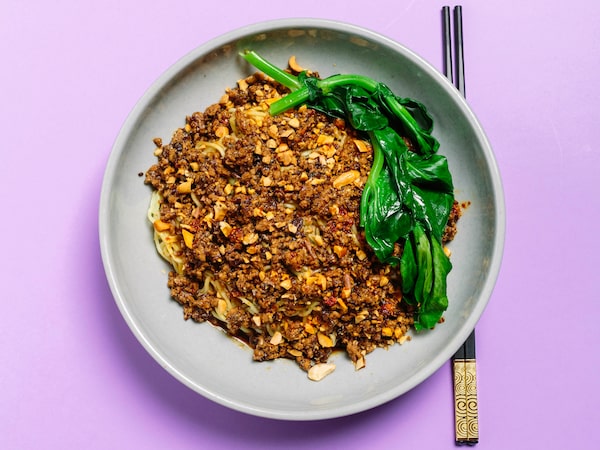
Gabriel Li/Supplied
My first taste of modern Chinese cooking was a fabulous dish of General Tso’s sweetbreads created by Nick Liu when he was the chef at the Niagara Street Café in Toronto (the Edulis forerunner). I was blown away by the sweet, sour, spicy dish. Today, Liu owns Dailo which serves ”new Asian” cooking. Liu is second-generation Hakka Chinese and trained as a French chef. He uses many French techniques to produce his exceptional cuisine.
Eva Chin at Avling in Toronto is another classically trained chef who is refining her cooking identity. Her eclectic menus span the globe using local Canadian ingredients with Asian and French techniques for something completely new.
There is significant controversy on how to define modern Chinese cuisine. Lillian Chow, a seafood importer who travels extensively in Asia, says the style “incorporates ingredients and presentation which aren’t normally considered Chinese. By interpreting traditional recipes with modern twists, it blurs the lines between not only regions of China but also diverse cultures such as Chinese and Japanese, Vietnamese or Thai.”
Conversely, modern Chinese is also described as authentic regional cooking and at restaurants that embrace this ethos, you’ll find innovative stylish vibes and great signature cocktails. Mimi Chinese in Toronto and Bonnie’s in Brooklyn, N.Y., are two to try.
David Schwartz, executive chef, and Braden Chong, head chef, of Mimi and its more casual sister restaurant, Sunnys Chinese, believe Chinese food “is the most historically rich, diverse food culture on the planet” and their restaurants strive to represent the best versions of these foods. Their approach is regional authenticity rather than modern innovation. Each menu dish has is origins stated.
My favorite takeout lunch in New York was Xi’an Famous Foods with authentic recipes from the Shaanxi province in China. The mouthwatering, tongue-tingling, spicy lamb with cumin tossed with hand pulled Biang Biang noodles was a winner. These are broad thick noodles, also known as belt noodles. (The story goes there wasn’t enough time to pull them thin.)
Dan Dan Noodles
Serves 4 to 5
This dish from David Schwartz and Braden Chong is a spicy and textured Sichuan dish. You can find some of these ingredients at the Mala Market online. I went to T&T Supermarket (which has locations across Canada) and was able to find everything except Sichuan chili oil. I did find other chili oils, however, which I substituted. Chili oil is full of flavour and heat with the addition of not just chilies but other spices too. The oil itself is full of little bits of ingredients. Make individual dishes for each person by dividing each element into 4 or 5.
Sauce
2 tbsp Chinese white sesame paste
1/2 cup aromatic Sichuan chili oil
¼ cup light soy sauce
4 tsp granulated sugar
1 tbsp Shanxi black vinegar
Pork mixture
1 tsp vegetable oil
200 g ground pork
2 tsp dark soy sauce
1 tbsp plus 2 tsp granulated sugar
Heaped ¼ cup (about 40 grams) fermented mustard greens, rinsed
450 grams (1 lb) fresh ramen noodles
Garnish
1 small bunch thinly sliced green onions
½ cup (75 gram) toasted and ground peanuts
Whisk together sesame paste, chili oil, light soy, sugar and vinegar until mostly emulsified. Reserve.
Heat a wok over high heat. add vegetable oil. Add pork and stir fry until pork is crispy, about 5 to 7 minutes. Add in dark soy, sugar and rinsed mustard greens and combine with the pork. Reserve.
Boil water in a large pot and add noodles. Cook for about 2 minutes or until they are tender but with some texture. Drain.
Place sauce in bottom of bowl.
Place noodles on top of sauce and garnish with pork mixture, toasted peanuts and green onions.
Substitutions and shopping tips
For Chinese white sesame paste substitute tahini.
For Sichuan chili oil use a chili oil available at your store. It may contain other ingredients but should mostly be just chilies. If you have a chili crisp, it will work but not be quite as authentic. A word of caution. Some chili oils are hotter than others. You can make your own by toasting about ¼ cup Chinese or other chili flakes in a pan until you can smell them. Cover with about 1 cup of neutral oil and let steep for a few days before using.
Shaanxi black vinegar is delicious but difficult to find. Best substitute: Chinkiang vinegar.
Ramen noodles are available fresh and frozen at most Asian markets or use thin Chinese fresh wheat noodles.
You can buy ground peanuts at Chinese stores, otherwise roast your own and grind in a food processor or spice grinder.
Need some advice about kitchen life and entertaining? Send your questions to lwaverman@globeandmail.com.